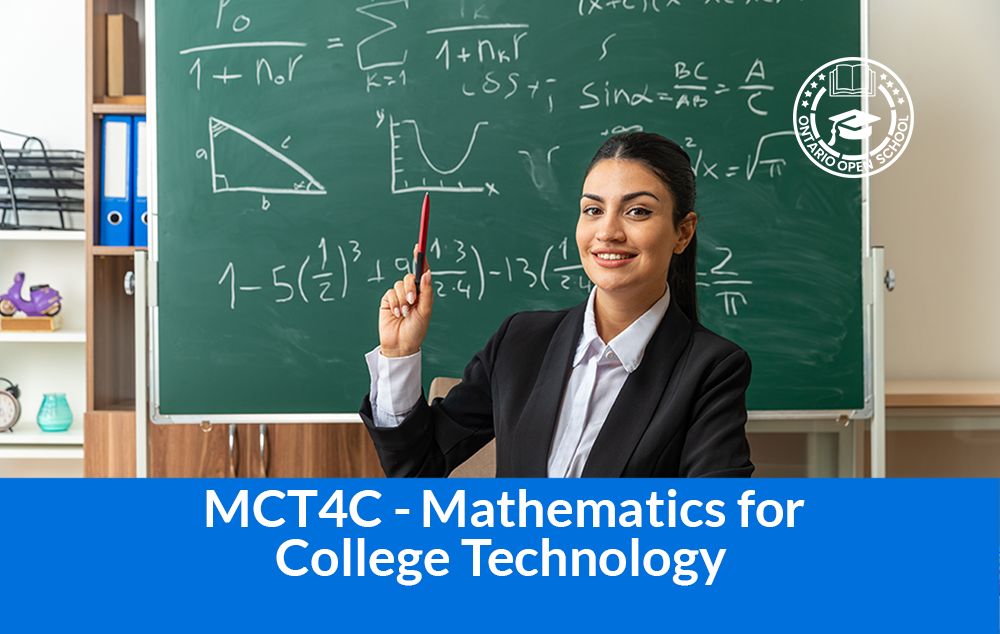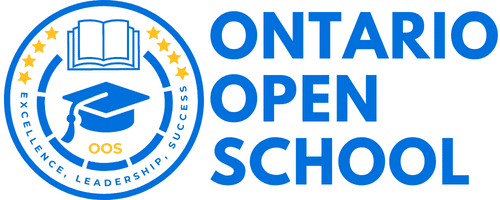- info@ontarioopenschool.com
- 647-494-4499
-
Unit 100 - 29 Gervais Drive, North York, ON.
M3C 1Y9
Copyright 2024 Ontario Open School Inc. All Rights Reserved.
This course enables students to extend their knowledge of functions. Students will investigate and apply properties of polynomial, exponential, and trigonometric functions; continue to represent functions numerically, graphically, and algebraically; develop facility in simplifying expressions and solving equations; and solve problems that address applications of algebra, trigonometry, vectors, and geometry. Students will reason mathematically and communicate their thinking as they solve multi-step problems. This course prepares students for a variety of college technology programs
Unit Order | Unit Name | Suggested Time |
|---|---|---|
| Unit 1 | Polynomial Functions By the end of this unit students will be able to: 1- learn to identify and describe some key features of polynomial functions and to make connections between the numeric, graphical, and algebraic representations of polynomial functions. 2- solve polynomial functions in a number of ways and apply their skills to solve real-world problems. | 21 hours |
| Unit 2 | Exponential Functions By the end of this unit students will be able to: 1- Learn Methods of solving problems involving the exponential function algebraically & graphically. 2- Learn about logarithmic properties then apply they knowledge of exponential & Logarithmic function to solve problems | 21 hours |
| Unit 3 | Trigonometry Functions & Graphs By the end of this unit students will be able to: 1- solve trigonometric problems quickly and with greater accuracy by making connections between trigonometric ratios and the unit circle. 2- Practice & review the sine and cosine laws, providing the necessary foundation to solve problems arising from real world applications. 3- Understand of trigonometry by expanding on the functions behind the trigonometric ratios. 4- Examine & investigate the graph of the trigonometric and how to be transformed to model a wide range of applications in our real world. | 29 hours |
| Unit 4 | Application of Geometry By the end of this unit students will be able to: 1- learn & understand important areas of geometry: Vectors, Measurement, and Circles. 2- introduced to the concept of vectors as measurements with both magnitude and direction. 3- add and subtract vectors using a variety of methods. 4- practice various real-world applications of vectors. The measurement module focuses on the metric and imperial system of measure, and the conversions between various measures and systems. 5- practice problems involving perimeter, area, and volume of shapes using both systems of measure. 6- introduced to the properties of circles and investigate methods for determining the area and perimeter of incomplete circles. | 29 hours |
| Final Evaluation 30% | Culminating Assignment Final Exam | 8 hours 2 hours |
| Total | 110 Hours |
A wide variety of instructional strategies are used to provide learning opportunities to accommodate a variety of learning styles, interests and ability levels. These strategies include, but are not limited to:
|
Strategies marked with “x” are used in the course. |
|||
| Direct Instruction (teacher-led) | x | Class Activity (teacher facilitation) |
x |
|
Direct Instruction (discussion possible) |
x | Experiential learning | |
| Class Discussion (teacher facilitated) | x | Worksheets/Surveys |
|
|
Small Group Discussion |
x | Individual or Group Research | |
| Partner Discussion/Conferencing | x | Teacher modeling |
x |
|
1:1 Conferencing Teacher & Student |
Text-based modeling | ||
| Teacher reading to class | Use of Computers / Internet Silent individual reading |
x |
|
|
Silent individual reading |
Use of video tape or audio materials | ||
|
Group based reading |
Role Playing |
||
| Independent Work (teacher facilitation) | x | Presentations |
x |
|
Group Work (teacher facilitation) |
Guest Speaker | ||
| Brainstorming | Field Trip |
|
|
Purpose
The primary purpose of assessment is to improve student learning. Assessment relates directly to the expectations for the course.
A variety of assessments for and as learning are conducted on a regular basis to allow ample opportunities for students to improve and ultimately demonstrate their full range of learning and for the teacher to gather information to provide feedback. Assessment tasks relate to the success criteria set out in lesson plans. Success criteria allow students to see what quality looks like.
Evaluation is the process of judging the quality of student work in relation to the achievement chart categories and criteria and assigning a percentage grade to represent that quality. Evaluation is based on gathering evidence of student achievement through:
Assessment for Learning – we provide feedback and coaching. Assessment FOR Learning is the process of seeking and interpreting evidence for the use of learners and their teachers to decide where the learners are in their learning, where they need to go, and how best to go there.
Assessment as Learning – we help students monitor progress, set goals, reflect on their learning
Assessment AS Learning is the process of the explicit fostering of students’ capacity over time to be their own best assessors, but teachers need to start by presenting and modeling external, structured opportunities for students to assess themselves.
Assessment of Learning – we use assessments to provide evaluative statements about student achievement. Assessment OF Learning is the assessment that becomes public and results in statements of symbols
(marks/grades/levels of achievement) about how well students are learning. It often contributes to pivotal decisions that will affect students’ future.
ASSESSMENT TOOLS
|
Assessment tools marked with “x” are used in the course |
|||
|
Marking schemes |
Rubrics |
||
|
Anecdotal comments |
Checklists |
||
|
Rating Scales |
|
||
|
Assessment for Learning |
Assessment as Learning | Assessment of Learning | |||
| Quizzes | x | Reflective journal | x | Tests |
x |
|
Tests |
x | Exit and Entrance Cards | Presentations | ||
| Presentations | x | KWL Chart | Journals |
|
|
|
Journals |
Self/Peer assessment | x | Essays | ||
| Essays | Logs | Models |
|
||
|
Models |
x | Projects | x | ||
| Projects | Demonstrations |
|
|||
|
Demonstrations |
x | Conferencing | |||
| Conferencing | Questioning |
|
|||
|
Questioning |
x | Independent Study Assignment | x | ||
| Assignment | Art Exhibits |
|
|||
|
Art Exhibits |
Researching | ||||
| Researching | Final Exam |
|
|||
|
Reading Aloud |
Problem Solving (Process focused) | ||||
| Problem Solving | x | Independent Study Test |
x |
||
|
Debates |
|||||
|
Work sheets |
|||||
|
Role playing |
|||||
|
Direct Instructions |
|||||
Resources
Grading
Weighting of categories
| Knowledge/Understanding | Thinking/Inquiry | Communication | Application |
| 25 % | 25 % | 25 % | 25 % |

Course Grade | Grade 12 |
|---|---|
Course Code | MCT4C |
Course Category | Mathematics |
Course Type | College Preparation |
Course Delivery | Online |
Course Duration | 110h |
Course Credit | 1.00 |
Copyright 2024 Ontario Open School Inc. All Rights Reserved.
